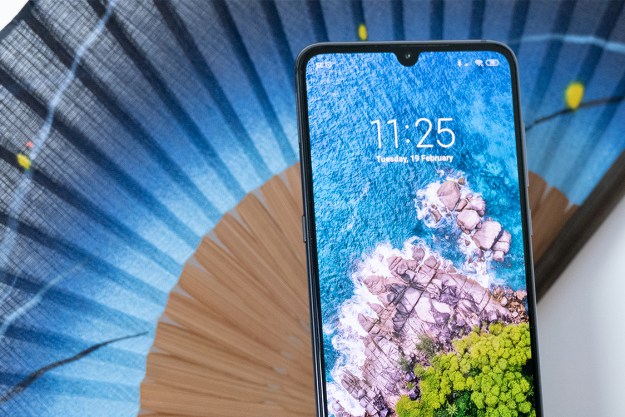
“The Xiaomi Mi 9’s Snapdragon 855 chip gives it more power than you’ll ever need, and it’s matched by great styling, a decent battery, and a capable camera.”
- Spectacular performance
- Beautiful styling and colors
- Long battery life
- Fast wireless and cable charging
- Reliable in-display fingerprint sensor
- Capable camera could be better
- Software needs improvement
- No water resistance
When you get behind the wheel of a really fast car, there’s always a moment in the first few miles when it feels so responsive, so alive, that you say to yourself, “wow, this is quick.” That’s what happens when you start to use your favorite apps on the Xiaomi Mi 9, which has the new Qualcomm Snapdragon 855 processor inside. It’s an absolute monster, and for once, the marketing claim that it provides a 45-percent greater performance than its predecessor doesn’t feel like an empty promise. The Xiaomi Mi 9 is a superphone, in the same way a Ferrari 488 GTB is a supercar.
It’s not superphone or supercar expensive though, making it one of the most exciting and desirable phones of 2019. We were so impressed, we gave it our coveted Best of Show award at Mobile World Congress 2019.
Speed, speed, speed
Speed, in a smartphone at least, is relatively hard to measure. We’ve run some benchmarks for reference, but also want to describe the experience here. The speed comes across in smoothness — it’s just so damn silky, which is definitely what strikes you first when using the Mi 9.
Next it’s the speed with which apps open, and then respond. There’s no slow down, everything scrolls smoothly, and if there is a hold up, you get the distinct impression it’s a network issue, rather than the device. The Xiaomi Mi 9 is so quick, it makes lightning bolts look sluggish and lazy.

How about the benchmarks?
- AnTuTu 3DBench: 361,283
- Geekbench 4 CPU: 3,536 single-core; 11,096 multi-core
- 3DMark SlingShot Extreme: 4,918 (Vulkan)
The AnTuTu 3D scores trounces everything before it, including the Samsung Galaxy S10, and even the iPhone XS. The Mi 9 is one of the first smartphones to use the Snapdragon 855, and its performance here makes us very excited about 2019’s flagship devices all round. It’s joined by 6GB of RAM and either 64GB or 128GB of internal storage space. A version with 12GB of RAM will be released in China, but won’t make it to the U.K. apparently, which is a shame, although we’re not sure it would make the phone any quicker during everyday use.
Don’t wonder, don’t hesitate, and don’t think I’m exaggerating — the Xiaomi Mi 9 is a fabulous, high-performance monster of a smartphone.
The Xiaomi Mi 9 is so quick, it makes lightning bolts look sluggish and lazy.
Sleek design
The Xiaomi Mi 9 looks like a supercar as well. Sleek and curvy, the phone is made from glass, with Gorilla Glass 5 on the back, and Gorilla Glass 6 over the screen. The sides of the rear panel gently curve before meeting the chassis, making it immensely comfortable to hold. There are four different looks — a black version you see in our main photos, along with a blue, a lavender, and a transparent finish too.
We’ll save you some decision-making time. The lavender Mi 9 is utterly stunning, and the one we’d choose to buy. That said, the transparent model is also very eye-catching, with some very cool details. No, you’re not looking at the actual components under that piece of 4D curved glass, but see if you can spot the reference to the Battle Angel codename, and the wireless charging symbol too. We’re confident you want the Mi 9, it’s just a case of choosing between the lavender or transparent finish.

Staying on the back, the triple-lens camera is set inside a large camera bump. It really is very prominent, and comes into direct contact with surfaces it’s laid on. Xiaomi said it has used sapphire glass over the lenses, meaning scratches shouldn’t be a problem, but independent tests have shown it’s not that much tougher than normal tempered glass.
We’re confident you want the Mi 9, it’s just a case of choosing between the lavender or transparent finish.
On the front, the 6.4-inch AMOLED screen has a teardrop notch, a 2,340 x 1,080 pixel resolution, and minimal bezels at the top and bottom. It looks excellent, and there are many customizations to make sure it looks exactly to your liking. For example, you can adjust the brightness in standard view or night mode, choose contrast and color levels, and automatically set a reading mode.
The downside of the glass body and subtle curves is the slipperiness. It simply doesn’t feel safe in your hand. There’s more grip on the average wet fish than there is on the Mi 9, and without a case, you tend to hold on so tightly the thin edges become a little uncomfortable. The glassy, glossy, slippery Mi 9 may feel like it’s an accident waiting to happen, but it’s so delicate and pretty, you’ll want to make sure it stays protected.
Triple cameras
This is the first time Xiaomi has used a triple-lens camera on one of its phones, and it has chosen the new Sony IMX586 sensor with 48-megapixels to headline the array. We’ve seen this already on the Honor View 20, and expect it to be one of the best cameras out there over the coming year. It’s joined on the Mi 9 by a 12-megapixel telephoto lens and a 16-megapixel ultra-wide lens with a 117-degree viewing angle.
Like Honor, the 48-megapixel mode is not activated as standard. You have to open the Settings menu and choose it from there, which is rather clunky. It also means there’s a chance people will forget about it, as it reverts to normal mode after the camera app is put to sleep, or be completely unaware they’re not shooting photos at the full resolution. The reason Xiaomi has done this is the 48-megapixel mode is really only suitable for some situations, like scenes in good lighting. The camera takes 12 megapixel shots as standard, and uses pixel binning technology to draw in more light and increase performance.
What’s it like? For the most part, excellent. The artificially intelligent night mode is effective at exposing more detail in low-light shots without sacrificing quality or detail, while not aggressively changing the image like the Pixel 3’s Night Sight mode. In sunny conditions, the blue sky pops in photos taken with the Mi 9, and the bokeh mode is great at adding subtle amounts of depth to a photo without taking away realism. We also like the flexibility and creative opportunity of having a wide-angle lens, a zoom, a night mode, various A.I. settings, and the large 48-megapixel mode all in one camera.
However, the software may need tweaking to bring out the best here. Exposure isn’t always very precise in standard mode, and a relatively pleasant blue sky late in the day came out rather grey and lacking in visual appeal. We also lost some photos when the camera app crashed after taking some 48-megapixel images and night mode shots, both of which require longer processing time which is where the app fell over.
A recent update to the camera has improved the situation, and added a new Moon Mode. This is specifically made to take photos of the moon, and is activated through the standard photo mode using artificial intelligence. The first batch of photos we took using it — with a tripod — were not very impressive, although again, we expect software tweaks over time to increase its ability.
Overall though, there’s plenty to enjoy at the moment, and some potential for improvement through future software updates too.
Security, battery, and charging
Xiaomi claims the Mi 9 has the fastest wireless charging yet seen in a smartphone. It uses a proprietary technology built into a special wireless charger to pump 20 watts of power into the phone’s 3,300mAh battery. The claim was an hour and 40 minutes to full on the special wireless charging puck, but this is conservative, and it rockets to full in about 90 minutes. Very impressive for wireless charging.
The Mi 9 has the fastest wireless charging yet seen in a smartphone.
You have to use the special Xiaomi wireless charger for this performance though, and it doesn’t come with the phone. It’s a serious piece of kit — about twice the thickness of a regular wireless charger, and it even has a fan inside that churns away when it’s charging the phone. The sound is enough that you won’t want it next to your bed, which is a shame. You also have to use the included Mi 9 charging brick and USB Type-C cable too. Ignore the fast wireless charging and plug in the cable alone, and things get even faster — expect a fully charged battery in just 65 minutes, based on our tests.
Now you’re probably looking at the relatively small capacity on the battery and thinking you’re going to need the fast charging pretty often. The excellent news here is you won’t, as the Snapdragon 855 is highly power efficient, and Xiaomi’s MIUI is adept at managing its power effectively, as even after an 8 a.m. to 10 p.m. day of using the phone consistently, it still had more than 40-percent charge left. Even on heavy days, we have not fallen below 15-percent after 15 hours of use. A 1,080p YouTube video played at maximum brightness for 10 hours 15 minutes before the battery was flat.
We’re also pleased with the new in-display fingerprint sensor on the Mi 9. It’s an updated version over the Xiaomi Mi 8 Pro, and it’s consistently more reliable than before. It’s more forgiving about finger placement, faster to unlock the phone than old versions, and works almost as reliably as a rear mounted fingerprint sensor too, although it still can’t quite match the speed. The Mi 9 doesn’t have face unlock, so this is an important step forward.
Software
Yes, the Xiaomi Mi 9 uses Android 9.0 Pie, but it’s heavily disguised underneath Xiaomi’s own MIUI 10 user interface, seen here in its “Global” form and in version 10.2. The positives include the outright speed, the attractive animations and transitions, the minimalist and well-designed icons and menus, and the intuitive gesture control system.
On the negative side, the notifications aren’t very reliable — messages are missed, and icons constantly lie to you — and there’s no app tray option, so all your apps stay on the home screen. Plus despite having NFC and setting it up, Google Pay refused to work in the U.K. on our review device. Software updates may fix these aspects in the future.
The most controversial aspect are the ads. Xiaomi is an ecosystem company, and in China runs its own app store along with a variety of other ways to make a profit, including serving ads on some of its pre-installed apps. This still exists on its phones sold internationally. It’s not constant, and it’s not in obnoxious places, but it can still be distracting and annoying. For example, download an app from Google Play, and MIUI will “scan” it for problems and let you know it’s fine … while displaying an ad.
These ads may also appear when using the installed music or video apps, and should perhaps be considered a necessary evil when paying so little for such a powerful device, although there are ways to disable them if you’re willing to spend time doing so. Whether you accept that you may be occasionally shown ads will be down to personal choice. We’re not fans, but because they never truly intrude on usage, we’re prepared to be slightly forgiving.
Price, availability, and warranty
The Xiaomi Mi 9 will be available in the U.K. soon, and is already available in Europe and China. The price in Europe is 450 euros ($510) for the 6GB/64GB model, and 500 euros ($570) for the 6GB/128GB version, which is the same as the Mi Mix 3. The U.K. price still to be confirmed, but it’s likely to match the 500 British pound ($660) Mi Mix 3. The phone will be available through Xiaomi’s own online store and its retail partners.

It won’t be sold officially in the U.S., but keen buyers will be able to import the phone through a third party. However, while it’ll operate with GSM networks like AT&T and T-Mobile, the bands may not fully support 4G LTE. We tested the phone in the U.K. on the EE network and it operated without issue.
Xiaomi provides a two-year warranty on its smartphones in the U.K..
Our Take
A super-fast smartphone that’s yours for a much lower price than expected, the Mi 9 shows how quickly Xiaomi is maturing, and how much it’s working on creating smartphones that appeal to those outside China. The Mi 9 is a compelling, high-performance smartphone that’s sure to become one of the year’s best.
Is there a better alternative?
Ignoring the price for a second, let’s talk about other smartphones with the Snapdragon 855 inside. The list is short, and the big competitors are the Samsung Galaxy S10e, as well as the Galaxy S10 and S10 Plus. The latter two are several hundred dollars more than the Xiaomi Mi 9, and the S10e is a little more expensive. They’re excellent, but it’s questionable whether you need to spend so much on a high performance smartphone today.
Put price back in the equation, and the Mi 9 stands above much of the competition at the moment due to the Snapdragon 855. You have the choice of the $550 OnePlus 6T, the 500 British pound ($660) Honor View 20, and the 550 British pound ($730) Samsung Galaxy A9 (2018). The $700 Nokia 9 PureView is a good alternative if you’re a serious photographer too.
How long will it last?
The hardware and technology inside is the best you can get at the moment, so buy it with the knowledge it will last you several years before you feel the need to upgrade. The body is made of glass, and as the phone is quite slippery it would be wise to put it in a decent case. The phone is not water resistant either, with no IP rating at all, so you’ll have to be careful with it.
Should you buy it?
Yes, the Xiaomi Mi 9 is one of 2019’s shrewdest smartphone purchases, in terms of performance-and-features-per-dollar.
Editors' Recommendations
- Google Pixel 9: news, rumored price, release date, and more
- Here’s our very first look at the Samsung Galaxy Tab S9 Plus
- New Xiaomi phones are launching on July 4 with (hopefully) amazing cameras
- Crazy 360-degree foldable phone rumored from Xiaomi
- Poco’s X4 Pro will look familiar to fans of another phone











